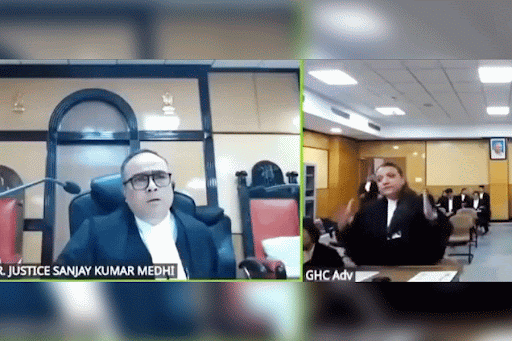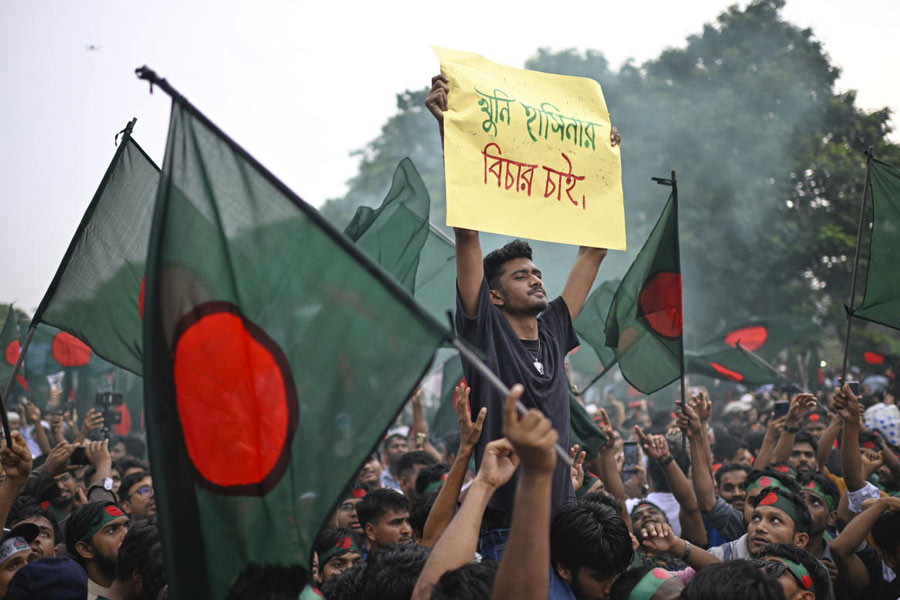

.jpg)



Gokulchand temple, built in 1643, is the tallest stone temple in Bankura; an octagonal Ras Mancha belonging to a De family. Photographs: Courtesy Kamal Banerjee
It is difficult to say exactly why it so happened, but it did. With the passage of years, as word spread about the eminence of the terracotta temples of Bishnupur in Bengal's Bankura district, the temples at Joypur, barely 15 kilometres away, slipped into oblivion.
Both the Bishnupur and Joypur temples were born of Malla patronage. Says Kamal Banerjee, a heritage researcher from the Indian National Trust for Art and Cultural Heritage (Intach), "Historically, we know that the Malla kingdom had shifted its capital from Padampur near Joypur to Bishnupur in the first half of the 16th century. Post-transition, all the major temple-building projects - both in terms of variety and artistry - were undertaken in and around Bishnupur. However, Joypur was not left barren. The grandest and probably the largest laterite stone temple, the Gokulchand shrine, was built here during the reign of Raghunath Singh in 1643. Equally important is the Shyamchand temple. There are also plenty of family-owned terracotta temples from the post-Malla period."
Unlike Bishnupur, the temples here do not form a cluster. Instead, they dot the countryside like random musings. The Vishnu temple, despite the disrepair, looks splendid against the greying July sky. Every inch of it is covered with tales from Krishna Leela. About three kilometres away lies the Gokulchand temple. Another four kilometres away is the Routhkhand temple with its fading frescoes. The 150-foot-high Radha Krishna temple has carved on it scenes from Mangal Kabya and the Mahabharata; the craftsmanship is so nifty that in places it creates a three dimensional effect. Even the rainwater outlets are sculpted. The principal deities of these temples - eight in all - are Radha and Krishna. The Mallas had intended the place to be a new Vrindavan.
At some point in time, when kings and kingdoms had withered away, the zamindars of the area - the Des and the Duttas - assumed responsibility for these terracotta wonders. According to village elders, with each successive generation the list of guardians increased but the guardianship denuded. Intach's Banerjee has a theory. He believes that inaccessibility owing to poor road connectivity contributed to the neglect of the Joypur temple heritage. And that's how it would have lived and died, had it not been for some local youth who took upon themselves the task of restoring and safeguarding the abodes of their godly neighbours.
Ghoton holds a day job as the security guard of a nearby village resort. Bubai has a shop of his own - he sells spectacles. Jagat works in the local forest office. All of them are in their mid-twenties. None can remember a time when the temples were in a better condition. Says Ghoton, "As a child, I remember being warned by my mother not to go inside these temples. She said they were full of snakes."
It is difficult to nail their restoration motivation story down to a date and time. But it seems there was a collective epiphany and that was enough to set things rolling this year. The local youth started by cleaning up the deserted Vishnu temple. "We cleared the dense overgrowth and dug water channels to put an end to waterlogging which was damaging the basement of the shrine and the panels on the lower walls," says Bubai. Also, since Bubai and his friends lived and worked in the vicinity, they began taking turns to patrol the temple premises.
Gopal, a school dropout who runs a tea-shop and is an active member of the group, says, "Contractors have a greedy eye on the laterite slabs of these temples. They steal these and use them to pave roads or replace the eroded steps leading down to the village ponds. Several villagers would also remove these slabs from the temples for their personal use."
"At Joypur, only the Gokulchand temple is protected by the Archaeological Survey of India. But it too has had no security arrangement in place the past five months," says B.N. Bhattacharya, another Intach representative. He has been to Joypur after being alerted about the condition of the temples by his colleague, Kamal Banerjee. Intach is only informally lending support to the locals. The funds, the manpower, the plan, all of it is the responsibility of the local youth. Bhattacharya adds, "The Shyamchand temple, located at Baital, a bit off the route, is plagued by undergrowth."
The temples' "local guardians" are well intentioned but not trained in restoration skills. They had engaged local masons to fix a crack in the ceiling of the Vishnu temple. Turns out, one of the masons poured a generous bucket of cement mix to seal the leak. It was just a coincidence that Banerjee, the heritage researcher from Intach, was in town then. He immediately organised a community briefing and explained the damage - aesthetic as well as structural - caused by the use of cement. Says Banerjee, "Before taking any kind of corrective step, there must be an attempt to understand the chemical composition of the original lime mortar. In this case, fortunately, only the roof was affected." Post this incident, the do-gooders understood the need to engage professional restorers and waited for expert advice before further repair work. They also worked out a road map.
The group has since then restricted itself to clean-up drives and only minor repair work. Block development officer Dhrubapada Sandilya has also swung into action. "I'll draw the government's attention to preserve the treasures and recommend a tourist guide training programme for the local youth," he says. With Intach-Calcutta's help, Sandilya recently organised a cycle rally with the local school students to create awareness about the terracotta temples. Apparently the women folk of the village are also keen to do their bit. "Like Yasin Pathan of Midnapore, our gram panchayat head, Fatima Bibi, is also keeping a close watch, especially on the Routhkhand temple," says Bubai. Panchayat and rural development minister, Shyamal Santra, has also extended support. After all, he is also from Joypur.
It is said Krishna left Vrindavan with the promise that he would be back some day. He didn't, and Radha's faith was broken. Radha herself was all but forgotten. For Joypur to regain its glory something has to be repaired, something beyond the brick and mortar. From the looks of it, it is a work in progress.










